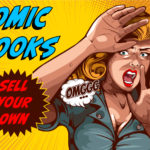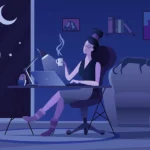Whether you’re an accomplished digital artist or only have some basic skills and a willingness to learn, start a digital art side hustle to earn some extra income. Here’s what you’ll need to get started…
To start a digital art side-hustle you’ll need a capable laptop and image-editing software as a minimum. You can learn the required skills for free on platforms such as YouTube. Sell your designs as stock images, prints or on print-on-demand products. Teach others by selling courses or with direct tuition.
Let’s get into the detail…
- Planning a Digital Art Side-Hustle
- What Hardware is Required for Creating Digital Art?
- Software Required
- Best Products to Make and Sell from Digital Art
- How Much Can You Earn from a Digital Art Side-Hustle?
- What Skills Are Required to Start a Digital Art Side-Hustle?
- Where to Learn Skills for Creating Digital Art?
If you find this post useful and want a more in-depth guide to starting and growing a creative side hustle then head over to my step-by-step guide. To learn how to scale your side-hustle into a full-time business then check out my post How to Turn a Creative Side-Hustle into a Business.
Planning a Digital Art Side-Hustle
It’s important to strike a balance between planning your side-hustle and taking action. It is a very good idea to research the side-hustle you’ll be going into, including the specific ways you’ll be monetizing your craft to avoid wasting your time in something unprofitable and ultimately demotivating.
However, it is even more important to actually take action since you will learn from your mistakes and refine your business as you go.
If you need some more detailed help on how to select a specific side-hustle then why not check out my post How to Choose a Creative Side Hustle: Step-by-Step Guide.
What Hardware is Required for Creating Digital Art?
Before you can begin to create anything you’re going to need to make an investment in some hardware. Chances are that if you’re reading this you may already be creating digital art as a hobby and therefore have some of the kit you’ll need already.
If that’s the case then good job! This side-hustle makes even more sense for you! For more detailed recommendations check out my post Essential Gear for Digital Creatives: Complete Guide. Alternatively if you will be creating while on the move see my post Create Digital Art & Designs While Traveling: Complete Guide.
All you really need to get started is a mid-range laptop that meets the recommended hardware specifications of the software you are going to use (see further down this post for that). Overall though, get the best that you can afford as it will last longer as software requirements continue to increase over time.
If you’re going get serious about your side-hustle then it’s a good idea to invest in some quality-of-life improvements to speed up your workflow and also improve your ergonomics. This can be done once you’re bringing in some cash or have decided that this is the side-hustle for you and are ready to commit.
Additional hardware items I strongly recommend are:
- A decent monitor – minimum 23 inch 2K resolution
- Drawing tablet – almost essential for digital artists
- Mouse and keyboard – improved ergonomics over integrated laptop input devices
- Desk and ergonomic office chair – look after your body if you’ll be spending many hours on your side hustle
Use your laptop as a second screen to speed up your workflow and increase available screen real estate. If your budget allows then consider purchasing a dedicated second monitor as well. Check out my post Do I Need a 4k Monitor for Photo Editing? for further guidance.
If your budget can stretch to it then some additional ‘nice-to-have’ hardware items are:
- Productivity mouse – additional shortcut buttons and better ergonomics
- Productivity keyboard – even more shortcut keys
- Editing console – dynamic shortcut controls to speed up workflow
- External hard drive – back up locally as well as to the cloud
For more details about editing consoles see my post What is an Editing Console and Do You Need One?.
Software Required
For digital art your essential software will be proficient at image editing, digital painting or vector art depending on what type of art you wish to create.
The industry-standard software package and one that I strongly recommend is Adobe Photoshop which will have you covered for image editing, manipulation and digital painting.
Adobe offer stand-alone subscriptions or as part of their wider software offering Creative Cloud, the latter of which has a sizeable discount available for students and teachers. See the Adobe site for more details (paid link).
Alternatives to Photoshop include:
- Clip Studio Paint – developed for manga and comic books and available on most devices.
- Procreate – excellent and intuitive painting app at a low price point. Only available on iOS.
- Rebelle – highly realistic mimicking of watercolour, oils and pastels.
- Corel Painter – accomplished painting software available to buy or via a subscription.
- Krita – Free open source painting program. You heard me. Free!
For vector art I suggest you consider another industry standard package, Adobe Illustrator which is also available as a standalone or included in Creative Cloud.
Best Products to Make and Sell from Digital Art
When it comes to digital art there are a lot of potential income streams open to you and I recommend using several of them to maximize the return from each of your designs.
We’ll run through some of the big-hitters here but for a more detailed run-down of your options, have a look at my post 35+ Ways To Make Money as a Digital Creative.
The most common products to create an income from your designs are:
- Print-on-demand merchandise
- Art prints
- Stock images
- NFTs
- Illustrated books
Print-On-Demand Merchandise
PoD is such a broad category and has become extremely popular with digital artists and entrepreneurs alike.
The most popular items are clothing, mugs and accessories with some marketplaces offering hundreds of different products for you to place your designs on. Hit the right product in the right design and you could earn big!
Merch by Amazon, Red Bubble and Society6 are the biggest print-on-demand marketplaces but it is also possible to integrate Etsy with a third part supplier such as Printify or Printful to dropship your goods their enormous customer base.
If using a marketplace, the income per item is small but in exchange for this you get access to millions of potential customers.
An alternative is to set up your own webstore using Shopify or WooCommerce and integrate this into Printify or Printful yourself. You will need to do your own marketing to get customers to your site but in tern you can retain more of the sale price and still not need to hold stock yourself.
Art Prints
A more pure way of monetizing your work is to sell art prints. This can be done via your own website by paying for a limited printing run and holding stock or using a third-party PoD service such as Printify or Printful.
Some of the print-on-demand marketplaces also feature posters or art prints as products and there are also dedicated art websites that will print and sell your work for you such as Art Web or Saatchi Art.
Stock Images
Selling stock image licenses is a pretty straight-forward process as there are far fewer steps after you’ve made your art compared to something like print-on-demand where you need to edit the artwork for the specific products and create detailed marketplace listings.
Most of the time you’ll retain the ownership to all your work as the marketplaces you’ll be listing on will be selling licenses for its usage. Make sure you check this however before signing up.
The key part to selling stock images is selecting the platform that suits your art style and provides you with the selling terms that are the most beneficial to your situation. You can either receive a royalty per license sold or a one-off fee per image submitted.
Platforms sometimes increase the amount of commission you may receive if you provide them with exclusivity or sell a larger number of images.
Popular stock image sites are:
NFTs
NFTs are Non-Fungible Tokens (meaning that they cannot be traded for each other directly) and work by ensuring that there is only a single valid digital original. NFTs allow this to be owned, sold and transferred to a single individual like a physical piece of art. The ownership record is held on a type of blockchain.
Selling images as NFTs got a lot of press when they first emerged due to some of the huge selling prices some images gained at auction. It’s important to remember that this is rare however.
There are costs to creating an NFT which requires a currency called Ethereum to be purchased and usually listing costs to then list these for sale on a marketplace.
Illustrated Books and Art Books
If you’ve generated a back-catalogue of art then it’s worth considering assembling some of your best pieces into an art book and self-publishing it on a platform such as Amazon’s Kindle Direct Publishing platform.
Alternatively you may decide that you want to create illustrated children’s books which can also be a profitable side-hustle. There will be a lot of extra steps required to create a book but it can yield some excellent results.
You will obviously need additional skills to write and edit the book or you can look to outsource these tasks from a platform such as Fiverr or Upwork.
For a more detailed guide on how to create an illustrated book, have a look at my post How To Create and Self Publish an Illustrated Book on KDP.
How Much Can You Earn from a Digital Art Side-Hustle?
How much you can earn from selling your digital art depends on how much you can create and the volume of sales you then generate.
Stock image sites usually provide royalties at between 15-40% with selling prices anywhere from $0.25 to $3 for a standard license to around $50 for an extended one. If you manage to sell 100 image licenses in a month then that could net you a few hundred dollars.
With many print-on-demand platforms you are able to set your own profit margin and sale price within some limitations. Set you price to be competitive when compared to other sellers but give yourself enough to make it worth your while. It’s a tricky balance and will be different for each marketplace you choose due to their varying customer base and product offerings.
A typical profit margin could be 20% which could translate to $25 on a framed picture or set it to 50% for a sticker and receive $2.50. It all depends on the type of product you select, how much it sells for and how many you sell.
If you create a great design for a sticker then you could earn hundreds of dollars on this small spontaneous purchase. Create an amazing piece of art that’s worthy of being a framed image and you only need to sell 10 of them to generate a similar income.
They key is knowing what types of product your art style is suited for and what gives you the best return for the time you take to make the original artwork.
What Skills Are Required to Start a Digital Art Side-Hustle?
If you’re still deciding whether to commit to starting a digital art side-hustle then the main skills you will need are:
- Creativity and attention to detail – obviously!
- Computer literacy – knowing your way round a computer isn’t optional
- Fast learner – you’ll need to learn some advanced software programs to get the best results
- Commitment – creating each piece of art can require a lot of hours. You’ll then need to rinse and repeat to create a continuous income
- Business sense – a side-hustle is a business so you’ll need to sell your artwork in a profitable way otherwise it is just a hobby
Where to Learn Skills for Creating Digital Art?
There is so much free and easily accessible information on the internet you shouldn’t need to pay to learn the skills you need. Just keep practicing every time you learn a new skill and you’ll be a pro in no time.
YouTube is the best place to pick free tips and tutorials. There are also many blogs out there such as this one, that provide free tutorials. Another good place to search is the included documentation within the software package you are using or on their website. For example Adobe offer a lot of free information on how to use their software.
Communities such as Reddit or Adobe Support Community are also invaluable for specific questions you may have so don’t be shy at posting. Chances are someone has also already asked your question before so have a poke around in there.
Good luck on your new exciting journey into the world of digital art side-hustles! If you’re ready to take it to the next level then learn how to scale your side-hustle into a full-time business in my post on the topic.
Featured image: LUMEZIA.com / stock.adobe.com
Adobe, Adobe Stock, Creative Cloud, Illustrator, Photoshop are either registered trademarks or trademarks of Adobe in the United States and/or other countries.








